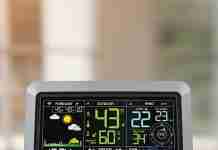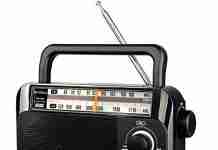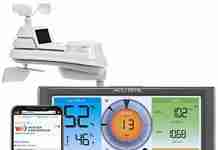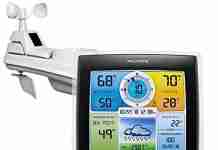Have you ever wondered if it’s possible to connect multiple home weather stations to just one base station? Well, we’ve got some news for you – it can be done! Imagine having real-time weather data from different areas of your property or even different locations altogether, all displayed on a single device. In this article, we will explore the possibilities of connecting multiple home weather stations to a single base station, giving you the convenience of monitoring weather conditions from various points simultaneously. So, strap in, weather enthusiasts, and let’s uncover the exciting world of multi-station connectivity.
Review contents
Overview
Weather stations are an essential tool for monitoring local weather conditions. They provide valuable data that helps us understand and predict weather patterns. Connecting multiple weather stations to a single base station can significantly enhance the accuracy and reliability of the collected data. In this article, we will explore how weather stations work, the importance of connecting multiple stations, and the benefits it brings.
How weather stations work
Weather stations are composed of various sensors and instruments that measure different weather parameters. These parameters include temperature, humidity, air pressure, wind speed, and precipitation. The sensors collect data and transmit it to a base station or console for processing and analysis. Some weather stations rely on wired connections, while others use wireless technology for data transmission.
Importance of connecting multiple weather stations
A single weather station can provide valuable local weather data, but it may not give a complete picture of the entire region. Connecting multiple weather stations allows us to collect data from different locations, providing a more comprehensive understanding of weather patterns. This is particularly important in areas with varying microclimates or complex terrain.
Benefits of connecting multiple weather stations to a single base station
Connecting multiple weather stations to a single base station offers several benefits. First, it enables the comparison of weather data collected from different locations simultaneously. This helps identify localized weather phenomena and improves forecasting accuracy. Additionally, by pooling data from multiple stations, we can establish more reliable long-term climate trends, aiding in climate research and analysis.
Another advantage is the ability to detect and track severe weather events more effectively. With multiple stations, we can monitor the progression of storms or other extreme weather conditions across a larger area. This information is crucial for early warnings and ensuring public safety.
Moreover, connecting multiple weather stations enhances the resilience of our weather monitoring system. If one station malfunctions or loses connectivity, the others can continue to operate, ensuring uninterrupted data collection. This redundancy is particularly valuable during critical weather events or when one station requires maintenance or repairs.
Compatibility
When considering connecting multiple weather stations to a single base station, compatibility is a crucial factor. Weather stations and base stations must be compatible to ensure seamless integration and optimal performance. Before purchasing any equipment, it is essential to evaluate compatibility requirements.
Considerations for compatibility
Compatibility considerations include the communication protocol, data format, and connectivity options. Different weather stations may use different protocols such as Wi-Fi, Bluetooth, or proprietary wireless technologies. It is important to choose stations that support the same or compatible protocols to ensure effective data transmission.
Data format compatibility involves ensuring that the measurements collected by each station are consistent and can be processed uniformly by the base station. Some weather stations provide standardized data formats, while others may require additional software or converters for compatibility.
Choosing weather stations with compatible base stations
To simplify the compatibility process, it is advisable to choose weather stations and base stations from the same manufacturer or within the same product line. Manufacturers often design their units to be compatible with each other, facilitating seamless integration. Researching and consulting product specifications can help identify suitable combinations.
Wireless vs wired connections
The choice between wireless and wired connections depends on various factors, including the distance between stations, the presence of obstructions, and the desired ease of installation. Wireless connections are convenient for shorter distances and when there are no significant physical barriers. They eliminate the need for running cables, simplifying installation and reducing maintenance efforts. However, wired connections offer better stability and reliability over longer distances and in areas prone to electromagnetic interference.
Setup Requirements
Setting up a network of multiple weather stations requires careful consideration of several factors. These include location considerations, power supply options, and ensuring the availability of necessary additional equipment.
Location considerations
The location of weather stations plays a crucial role in obtaining accurate and representative data. Stations should be positioned in open areas, away from buildings, trees, or other obstructions that might alter airflow or shield the sensors. For multiple stations, it is essential to select distinct locations that capture the diversity of the region’s weather patterns. This ensures a comprehensive understanding of weather conditions across the area of interest.
Power supply options
Weather stations require a stable power supply to operate continuously. Depending on the location and availability of power sources, various options can be considered. Some stations can be connected to traditional electrical outlets, while others may rely on solar panels or batteries for power. Assessing the power requirements of each station and selecting the appropriate power supply option is essential for uninterrupted data collection.
Additional equipment needed for multiple weather stations
When connecting multiple weather stations, additional equipment may be necessary to facilitate communication and data consolidation. This includes antennas or repeaters to extend the wireless range, routers or switches for network connectivity, and data loggers or software to consolidate and analyze the collected data. Ensuring the availability of all required equipment before installation is crucial for a successful setup.
Connecting Multiple Weather Stations
Connecting multiple weather stations to a single base station can be achieved using various techniques. Understanding the limitations of a single base station, utilizing additional base stations or consoles, and creating a network of weather stations are viable approaches.
Understanding the limitations of a single base station
A single base station has limited range and capacity, making it challenging to collect data from multiple weather stations that are far apart or in areas with poor connectivity. It is important to assess the coverage area and transmission capabilities of the base station to determine if additional measures are needed for comprehensive data collection.
Using additional base stations or consoles
In scenarios where the coverage area or connectivity limitations are significant, adding additional base stations or consoles can help overcome these challenges. Multiple base stations can operate independently or be connected to form a network that consolidates data from all stations. This approach ensures adequate coverage, data integrity, and seamless data transfer.
Creating a network of weather stations
For larger-scale installations or when geographically distant weather stations need to be connected, creating a network of weather stations is beneficial. This involves establishing a centralized server or hub that collects and manages data from all stations. The network configuration should prioritize data transmission efficiency, network redundancy, and accessibility.
Data Management
Managing data from multiple weather stations requires proper consolidation, analysis, and storage. Various techniques and tools are available to streamline data management processes and extract meaningful insights.
Consolidating data from multiple weather stations
Data consolidation involves organizing and merging data collected from multiple weather stations into a central database or system. This ensures that all measurements are accessible in a unified format for analysis and visualization. Data consolidation can be achieved using dedicated software, data loggers, or by leveraging cloud-based solutions.
Analyzing and visualizing data
Analyzing and visualizing weather data allows us to identify patterns, trends, and anomalies for deeper understanding and decision-making. A variety of software tools and platforms offer data analysis and visualization capabilities tailored for weather data. These tools enable the identification of correlations, the creation of graphs and charts, and the generation of reports for scientific, professional, or personal applications.
Cloud-based solutions for data management
Cloud-based solutions provide an efficient and convenient means of managing data from multiple weather stations. With cloud storage and analysis platforms, data can be securely stored, accessed, and processed from anywhere with an internet connection. Cloud solutions often offer data visualization features, automatic backups, and collaboration capabilities, making them suitable for both personal and professional use.
Network Configuration
Configuring the network to maximize data transmission and reception is vital for optimal performance of multiple weather stations. Proper network configuration ensures stable connectivity, minimizes data loss, and enables real-time monitoring and analysis.
Configuring the network for multiple weather stations
Network configuration involves setting up routers, switches, or other networking devices to ensure seamless communication between weather stations, base stations, and other network components. Proper IP addressing, network security, and Quality of Service (QoS) settings are essential to maintain stable and reliable connections.
Maximizing data transmission and reception
To maximize data transmission and reception, factors such as signal strength, interference, and data transfer rates must be considered. Positioning antennas or repeaters strategically can enhance wireless connectivity, while using high-quality cables and connectors improves wired connections. Monitoring data transfer rates and adjusting network settings can help optimize the flow of data from weather stations to the base station.
Troubleshooting connectivity issues
Despite careful planning and implementation, connectivity issues may occasionally arise. Troubleshooting techniques such as checking hardware connections, updating firmware, adjusting signal strength, or reconfiguring network settings can help resolve connectivity problems. Regular monitoring and maintenance are necessary to ensure continuous operation of the weather station network.
Integration with Other Systems
Integrating weather stations with other systems expands the usefulness and potential applications of weather data. Weather data can be incorporated into smart home systems, connected to online platforms, and integrated into professional applications.
Integrating weather stations with smart home systems
Integrating weather stations with smart home systems enables automation and intelligent decision-making based on real-time weather conditions. Weather data can be used to control heating and cooling systems, adjust sprinklers, or inform energy-saving strategies. Integrating weather stations with smart devices and platforms enhances the convenience and efficiency of smart homes.
Connecting weather data to online platforms
Weather data is in high demand by individuals, organizations, and online platforms for various purposes. By connecting weather stations to online platforms, users can access real-time or historical weather data from anywhere with an internet connection. Weather enthusiasts, researchers, or businesses can leverage this data for personal or professional use, including agricultural planning, event management, or climate studies.
Incorporating weather data into professional applications
Weather data plays a critical role in various professional applications. Industries such as agriculture, aviation, construction, and renewable energy rely heavily on accurate and up-to-date weather information. By incorporating weather stations into these applications, professionals can make informed decisions, optimize operations, and mitigate risks based on real-time weather data.
Maintenance and Upkeep
Proper maintenance and periodic upkeep are necessary to ensure the longevity and reliability of weather stations and base stations. Regular maintenance routines, firmware and software updates, and troubleshooting common issues are essential tasks.
Regular maintenance of weather stations and base stations
Weather stations and base stations should undergo routine maintenance to keep them in optimal condition. This includes checking and cleaning sensors, inspecting cables and connectors for damage, and calibrating instruments if required. Following the manufacturer’s guidelines for maintenance and performing regular checks help maintain data accuracy and reliability.
Updating firmware and software
Manufacturers often release firmware and software updates to improve functionality, fix bugs, and enhance compatibility. Regularly updating the firmware and software of weather stations and base stations ensures access to the latest features and improvements. Before performing updates, it is advisable to backup data to prevent any potential loss.
Troubleshooting common issues
Weather stations may encounter common issues such as signal interference, inconsistent measurements, or connectivity problems. Troubleshooting techniques may involve verifying connections, adjusting sensor positions, or resetting network settings. Consulting user manuals or contacting manufacturer support can provide guidance in resolving these issues effectively.
Considerations for Large-scale Installations
Large-scale installations involving numerous weather stations require careful planning and considerations specific to such projects. Scalability, data management, and professional installations and monitoring services play significant roles in successful large-scale deployments.
Planning for scalability
Scalability is a crucial consideration when deploying multiple weather stations for large-scale projects. Ensuring that the network architecture, hardware, and software can handle the increasing number of stations is essential. It is vital to choose scalable solutions that allow for easy expansion and the addition of new stations as the project evolves.
Managing data from numerous weather stations
Managing data from numerous weather stations necessitates efficient storage, processing, and analysis capabilities. Robust infrastructure, such as high-capacity servers or cloud-based solutions, is essential for handling the influx of data. Additionally, implementing data management protocols, such as data archiving, automated backups, and data integrity checks, ensures data reliability and accessibility.
Professional installations and monitoring services
For large-scale installations or mission-critical applications, professional installations and monitoring services are advantageous. Professional installers can ensure that all stations are correctly positioned, connected, and configured for optimal performance. Monitoring services provide continuous oversight, allowing for rapid troubleshooting and timely maintenance when issues arise.
Conclusion
Connecting multiple home weather stations to a single base station offers numerous benefits, including enhanced data accuracy, broader coverage, and improved forecasting capabilities. By carefully considering compatibility, setup requirements, and network configuration, we can create a robust and reliable weather monitoring network. Integrating weather stations with other systems and applications allows for even more extensive use and customization. Regular maintenance and considering scalability for larger installations ensure the longevity and effectiveness of the weather monitoring network. With the right setup and proper management, we can significantly enhance our understanding of local weather conditions and contribute to various sectors that rely on accurate weather data.



































